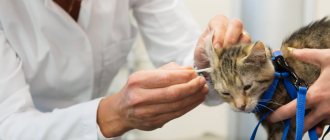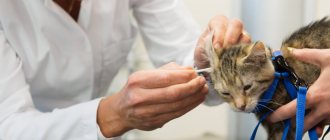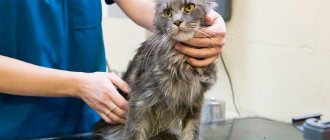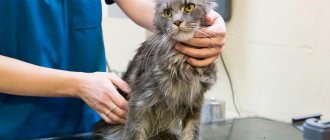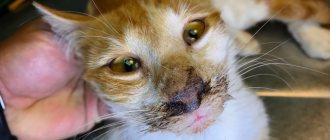Cancers in cats are quite rare. It is very important to undergo various tests periodically. This will help prevent the disease and possibly slow down its development, thereby extending the life of your four-legged friend. And if tests confirm that cats or cats have cancer, then don’t be upset. No one promises that the fight against such a terrible disease will be easy. However, it is with your help that the animal will live a long and happy life. Properly selected treatment will help the fluffy live for a very long time, delighting you with his presence.
Causes and individual susceptibility
The main cause of oncology is DNA damaged by carcinogens . The factors that provoke the appearance of cancer have not yet been fully determined. However, experts have identified several reasons that contribute to the development of a tumor in a cat.
Heredity
- Hereditary predisposition. The risk of getting sick increases significantly in animals whose family has had cancer for several generations.
- Weakened immunity. The protective function of the body is reduced due to poor ecology, improper feeding, previous diseases, and a sedentary lifestyle.
- Injuries to internal organs , as well as fractures and bruises can cause a tumor.
- Low-quality feed, saturated with chemicals and preservatives, increases the likelihood of developing cancer.
- Frequent or prolonged stress significantly worsens the pet’s condition and contributes to the development of many serious diseases, including cancer.
- Malfunctions of the hormonal system. Most often, this factor manifests itself in unsterilized animals, whose owners, instead of surgery, resort to hormonal drugs to reduce sexual desire.
- Prolonged exposure to the sun. Prolonged exposure to ultraviolet light can cause skin cancer.
- Chronically inhaling tobacco smoke significantly increases the risk of developing lung cancer.
The development of cancer does not depend on the breed or age of the pet. The disease can strike a kitten, a healthy young cat, or an older animal. But still, cancer is more often diagnosed in animals older than five years, and the peak incidence occurs at 10–12 years of age. Among cats over 12 years old, the percentage of cases decreases.
Causes of diseases
- Genetics. The main cause of cancer, as in humans, is genetics. Cancer is a mutation of certain genes, and they occur independently of us. In some cases, mutations are benign, and sometimes lead to the death of the organism.
- Carelessness. Cancer can develop from neglected or incompletely cured diseases, due to hormonal imbalance in the functioning of the body.
- Lack of care for the pet. In any case, if you do not follow the correct diet for your animal, or do not provide it with an active lifestyle, sooner or later it will get sick. Cancer is just one of the possible diseases.
Types of oncology
Depending on which organ is affected, there are different types of oncology in cats:
Mammary cancer
- breast cancer – a neoplasm develops inside the mammary glands;
- lymphoma (blood cancer) – cancer cells affect the lymph nodes, spread through the lymphatic system, affecting the bone marrow and liver;
- sarcoma (osteosarcoma, fibrosarcoma, liposarcoma) is the most aggressive type of oncology, characterized by rapid spread throughout the body;
- carcinoma and adenocarcinoma affect the epithelial tissue of internal organs, skin, mucous membranes (the oral cavity, stomach, intestines, and lungs are most often affected);
- squamous cell carcinoma is often localized in the oral cavity (gums, palate, tongue, tonsils suffer).
Most often in cats, intestinal, stomach, skin, blood, lung and mammary gland cancers occur (mainly in older animals). Stages of disease development and symptoms
There are four stages in the development of a malignant tumor:
- The first stage is characterized by the absence of obvious symptoms and the presence of a small, strictly localized tumor node.
- The second stage - the tumor grows, gradually growing into the tissue of the organ and metastasizing to nearby lymph nodes.
- The growth of the tumor slows down , there are more and more metastases, they spread throughout the body.
- Cancer spreads over large areas. At this stage, the disease is considered irreversible and in most cases leads to the death of the animal.
The main sign of oncology is the appearance of neoplasms. But this symptom noticeably manifests itself already in the later stages of the disease. The onset of the process can be determined earlier by a combination of other signs.
Squamous cell carcinoma
Symptoms of cancer in cats depend on the location of the tumor and the stage of its development. These include:
- changes in behavior, apathy, anxiety, constant meowing for no apparent reason;
- loss of appetite;
- weight loss;
- change in body temperature;
- enlarged lymph nodes;
- bleeding gums, putrid breath;
- difficulty breathing, shortness of breath;
- skin pigmentation;
- dry cough (sometimes developing into a prolonged attack);
- the appearance of non-healing ulcers on the skin;
- traces of blood in urine or feces;
- persistent bowel dysfunction (constipation or diarrhea);
- frequent vomiting;
- the appearance of bumps, swelling on the nose, lips, in the mouth, in the ears, near the mammary glands, in the groin area, on the pads of the paws.
If you notice uncharacteristic behavior of your pet, deterioration in physical condition, or one of the above signs, it is advisable to visit a veterinarian as soon as possible and undergo the necessary examinations.
If cancer is confirmed
First of all, it is necessary to try not to despair and not to consider cancer as the “last” disease of our time, strongly associated with suffering. Veterinary oncology is developing rapidly. The accumulated knowledge of practicing doctors in this area will either cure the animal completely or significantly prolong its life, reducing the intensity of the disease, i.e. improve the animal’s condition by reducing the rate of disease development and prolonging a good quality of life.
Diagnosis and treatment
The algorithm for diagnosing cancer consists of several steps.
Blood analysis
- Blood and urine tests allow you to evaluate the functioning of internal organs and the general condition of the body.
- X-ray examination serves to determine the location and size of the tumor, as well as to assess the extent of metastases.
- Ultrasound diagnostics helps to detect tumors that are located shallowly.
- Magnetic resonance imaging.
- CT scan.
- Biopsy. Tissue collection for research is carried out in three ways: using a puncture, endoscopic or surgical.
Treatment is prescribed based on the type of tumor and the stage of its development. Main methods of therapy:
- surgical removal of a tumor – a fairly high percentage of positive outcomes when the operation is performed at the initial stages of the process;
- chemotherapy – drugs are introduced into the body according to a prescribed regimen that inhibit the growth and division of mutated cells;
- radiation therapy – locally destroys cancer cells;
- Immunotherapy – designed to strengthen the immune system, activate the body’s protective functions, and is used in combination with other methods in the treatment of all forms of oncology.
There is no single treatment plan for cancer. The doctor prescribes a treatment plan individually for each case, taking into account the diagnosis, condition, and age of the animal. Some types of cancer are completely curable. In others, if competent treatment is prescribed in a timely manner, the pet can live for many more years.
Oncological alertness is the key to successful cancer treatment
Once you discover a tumor in your pet, you should not expect it to disappear on its own. Do not waste such precious time for you and for the doctors. In the later stages, diagnosing the malignancy of the tumor does not cause difficulties, but treatment is much more difficult. More often than not, this is the reason why we are unable to help our patients and they still die from cancer.
Remember that a complete cure is only possible with timely treatment and early diagnosis of tumors.
Our clinic is attended by a specialized veterinary oncologist, Elena Nikolaevna Shvydkina.
Appointments with an oncologist are by appointment .
Prevention measures
There are no 100% methods to prevent cancer, but following some recommendations will help significantly reduce the likelihood of the disease:
Balanced diet
- high-quality, balanced nutrition;
- regular treatment against parasites;
- timely vaccination, scheduled visits to the veterinarian;
- limiting sun exposure;
- sterilization carried out before the first heat;
- refusal of hormonal drugs to normalize sexual behavior;
- activities aimed at strengthening the immune system;
- care and good attitude towards the pet, protection from stressful situations.
Cat cancer cannot be dangerous to humans. According to numerous studies, the owner cannot become infected from a pet, regardless of what type of tumor and at what stage it is detected.
Cancer in cats: diagnosis or what tests and studies need to be done
Of course, a caring owner will have to run to the doctors, but this will be fully repaid by the gentle purring of his pet, and for this to happen, the following types of research need to be carried out:
- Ultrasound
- MRI (MRI has established itself as one of the most accurate research methods)
- X-ray
- CT
- Take all kinds of blood tests, examining it from all sides
- Histological examinations
- Endoscopy.
However, this disease is so insidious that even these research methods may sometimes fail to detect a dangerous disease.
Cancer in cats: treatment
Maintenance therapy for oncology is chosen together with the attending physician, who observes and decides how to treat the animal. There are 4 possible scenarios:
- Surgical intervention - the tumor is removed surgically; this method is relevant when the cancerous tumor has not grown.
- Chemotherapy is special drugs that are designed to inhibit the active activity of tumors and prevent their further division and development.
- Radiation therapy is a direct effect on the tumor using special radiation at the site of the disease.
- Immune support therapy is an adjunctive therapy that should be used in addition to all types of cancer in combination with other treatments. The essence of the treatment is that the body’s resistance to dangerous cells increases in cats.
As you can see, maintaining life and treating cancer in cats is quite a labor-intensive, but very rewarding task. It is impossible to cure cancer completely, but you can keep your beloved animal alive for several years
.
Prevention to prevent cancer in cats
It is easier to prevent any disease than to treat it later. Today there are no exact methods that would 100% help prevent cancer in cats, but there are general recommendations that will help prevent trouble:
- Preventive measures:
- Constant care, love for the animal, so that it is less nervous and does not experience stress at all (this is ideal).
- High-quality nutrition with sufficient amounts of nutrients.
- Timely prevention of worms.
- Maintain your cat's immunity in good condition.
- Get your vaccinations on time and visit your veterinarian regularly.
- Avoid direct exposure of the cat's skin to direct sunlight.
- Having time to sterilize before the very first heat, this will also help avoid tumors.
Your cat should be constantly monitored by a doctor who will not miss the oncological process and will begin the necessary research in a timely manner. to take your beloved pet to the doctor for a preventive examination at least
. Need an oncologist to examine your pet? Please! For a reasonable fee, Dr. “YA-VET” will examine your pet from head to toe and find out why the purr stopped playing and refuses his favorite food.
Cancer in cats: which veterinary clinic is best to go to?
If you suspect cancer in cats, do not delay contacting your veterinarian. Doctors at the Ya-VET clinic constantly undergo advanced training courses, which guarantees the accuracy and reliability of the results.
The most modern equipment allows you to perform MRI and ultrasound with high quality and safety. You should not skimp on the safety and health of your pet, because the future health of your four-legged friend depends on your efforts. For especially severe cases, we have highly specialized specialists who have extensive experience in their field and will be able to make a diagnosis in accordance with tests that can be taken right away. Let's assume they passed the tests and did an ultrasound. “What’s next?”, every attentive owner will ask?
And then there will be difficult, long-term treatment, which, however, with our professional specialists, will be clear and understandable. The clinic has all the necessary equipment that will help diagnose cancer at the earliest stages and successfully treat it. Don’t be upset, because pets are very sensitive creatures and easily perceive the mood of their owners. Everything is transmitted to them: sadness, sadness, resentment and much more. Try to maintain an optimistic attitude.
What to do if I can’t visit a veterinarian on my own - cancer in cats
It is for such cases that we have a special service - a veterinary oncologist visiting your home . A highly specialized specialist will come to your home within 40 minutes after the call
. We understand perfectly well that every minute is important, especially when there is such a serious illness.
And we try to get help on time. However, if surgical intervention is required, we can help transport the animal to the veterinary center. And in the veterinary clinic itself, provide all the necessary assistance. For your comfort, we have a comfortable hospital where you can wait for your pet’s rehabilitation. Remember that you can stop the cancer process in your pet’s body! To do this, you just need to call and the doctors will make every effort to neutralize the mortal danger as soon as possible.
If you have more than 1 cat, then we strongly recommend a preventive examination, which will help save another weak life. There is no need to worry or be afraid of bad forecasts. Leave your best efforts to ensure your pet’s recovery as soon as possible. Believe me, all the costs will be more than recouped when your furry pet jumps off the operating table happy and joyful.
Once you have used such a convenient service as a veterinarian at home, you will no longer want to come to a regular clinic on your own and waste time and nerves on the road. Why, if it is better to spend it on your beloved four-legged friend.
What types of cancer most often lead to pleurisy?
The prognosis of pleurisy in oncology depends on the organ affected by cancer. The highest survival rate has been established for malignant tumors of the breast and ovaries. The prognosis for pulmonary pleurisy in oncology is much worse. To determine the outcome, the LENT scale is used, which takes into account not only the condition, but also the patient’s functional capabilities.
Most often, pleurisy develops with cancer:
- lung (24-50% of patients);
- ovaries (up to 10%);
- breast (48%).
Less commonly, a complication occurs in the presence of a malignant process in the colon, stomach and pancreas - from 1 to 6% of cases. The prognosis and therapeutic options are determined by the prevalence and nature of the tumor process. The degree of sensitivity to drug therapy matters.
If a malignant tumor is sensitive to cytostatics, as in ovarian, breast and lung cancer, then with timely adoption of therapeutic measures it is possible to prevent relapses of exudation. If systemic therapy is ineffective, pleurodesis is performed to improve the prognosis.
What are the predisposing factors of the disease?
In most cases, it is impossible to accurately answer the question: “Why did the cat get cancer?” However, there are many predisposing factors that lead to cancer:
- poor immune system;
- genetic predisposition;
- regular poor quality nutrition;
- microtrauma of internal organs;
- passive smoking (tobacco smoke is very harmful to the body of cats);
- insufficient physical activity and poor lifestyle in general;
- hormonal disbalance;
- constant stress;
- bacterial, fungal and viral infections;
- ionizing radiation;
- polluted ecology.

